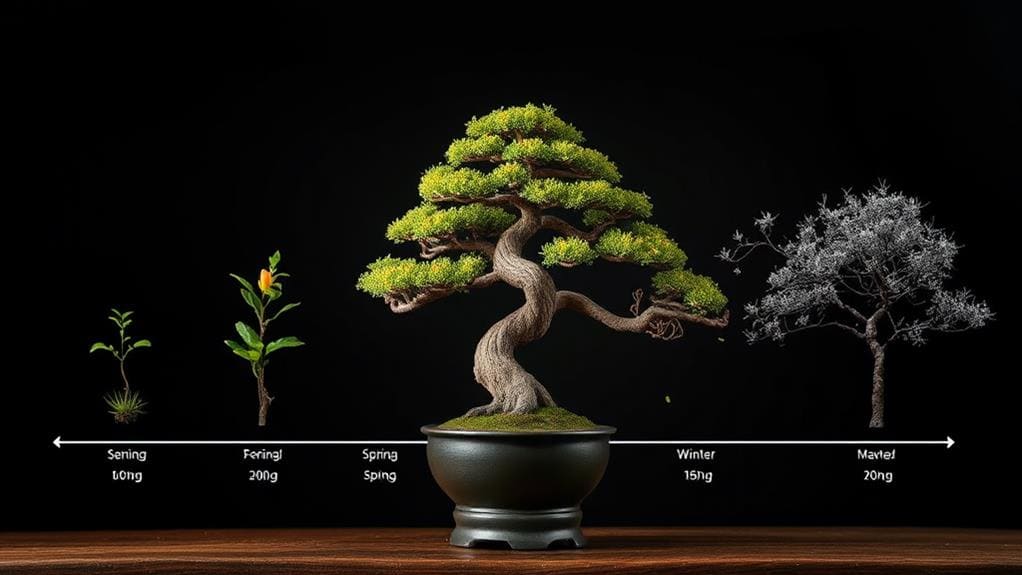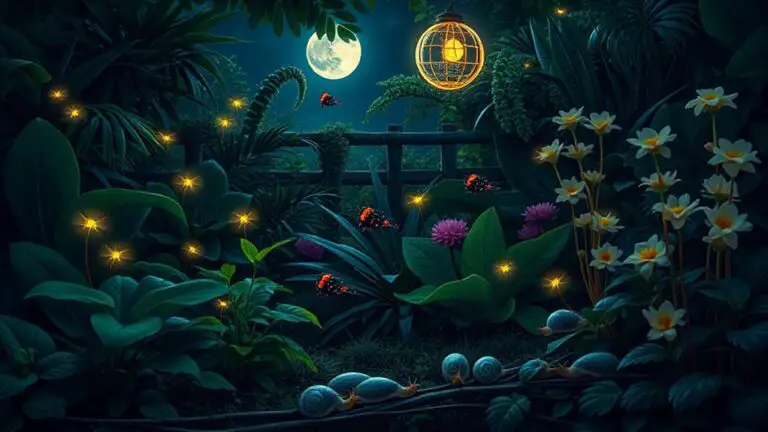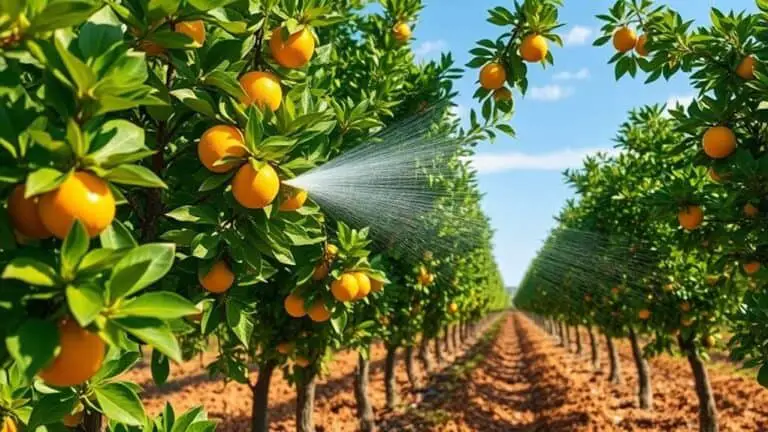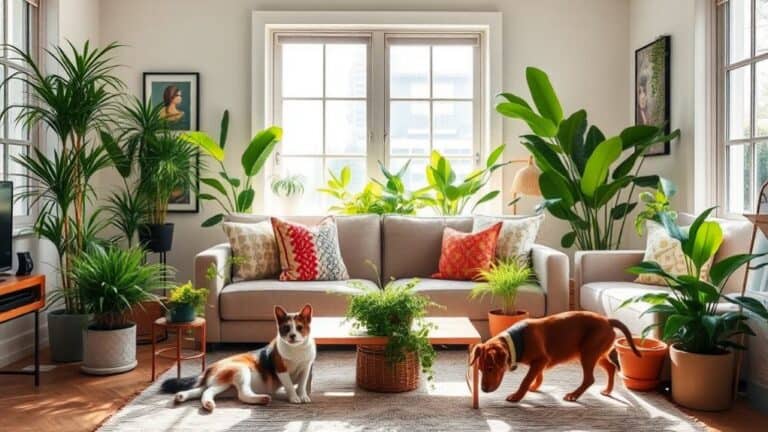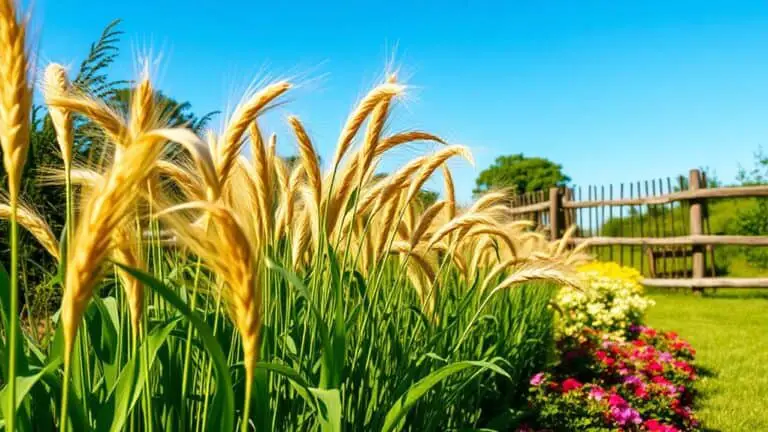How Long Does It Take For Bonsai Tree To Grow
When we talk about growing bonsai trees, patience is key. It typically takes at least five years for a bonsai to achieve its miniature size, with full maturity often taking 10 to 15 years. However, this timeline can vary greatly depending on the species and the care techniques used. Factors like water, soil quality, and meticulous maintenance play essential roles. Ever wondered how some bonsai can thrive for over 1,000 years while others last just a fraction of that time? Let's explore what it truly takes to nurture these living works of art.
Understanding Bonsai Trees
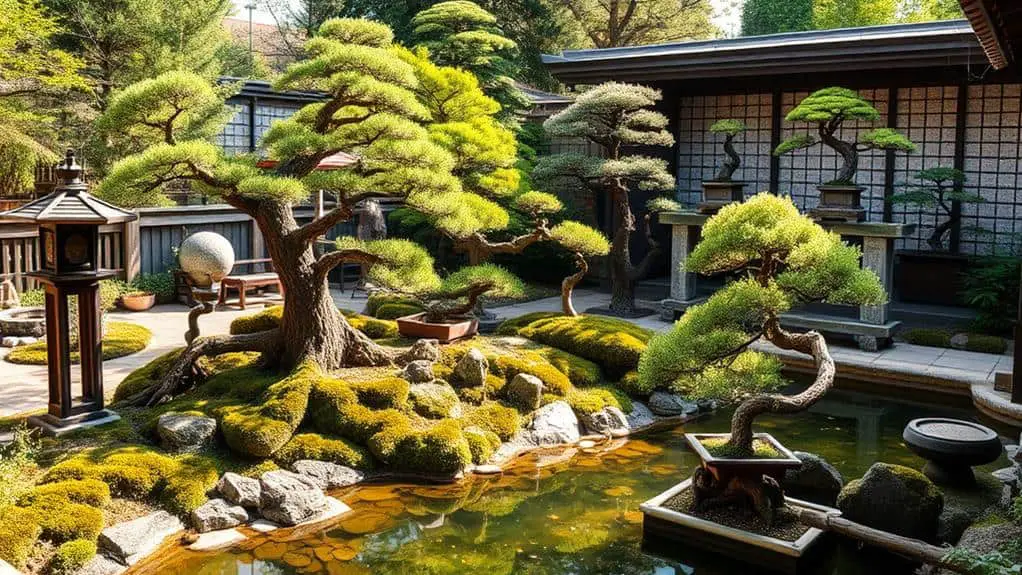
Bonsai trees aren't just miniature versions of full-sized trees; they're living art forms crafted through meticulous care and cultivation.
Growing bonsai involves more than just planting a tree in a small pot. Each species, from the elegant maple to the resilient juniper, requires special techniques to guide bonsai tree growth. You carefully trim roots and branches, shaping them into intricate designs.
The term "bonsai" means "planted in a container," reflecting its deep roots in Chinese and Japanese traditions. Mastering this art takes patience and attention.
It's not just about keeping the tree small; it's about creating a harmonious balance between nature and nurture. With dedication, anyone can experience the rewarding journey of growing bonsai.
Growth Duration and Lifespan
Let's talk about how long it takes for a bonsai tree to grow and how long they can live.
Bonsai trees go through different growth phases, taking at least 5 years to become small and up to 15 years to mature.
Depending on the species and care, these miniature trees can live anywhere from 50 years to over 1,000 years, making them a long-term commitment.
Bonsai Growth Phases
Growing a bonsai tree is a journey that demands patience and dedication, as it typically takes a minimum of 5 years for a tree to reach a miniature size. Most bonsai enthusiasts understand that bonsai trees grow in distinct phases, heavily influenced by growing conditions. Seeds need 3-5 years before they can be styled, while pre-bonsai saplings can speed up the process. Growth rates vary; for example, Ficus grows 1-2 feet indoors, while Junipers grow 6-12 inches per year. Full maturity often takes 10-15 years.
| Phase | Time (Years) |
|---|---|
| Seed to Bonsai | 3-5 |
| Pre-Bonsai Sapling | 2-3 |
| Miniature Size | 5 |
| Full Maturity | 10-15 |
| Lifespan | 50-80 |
Nurturing a bonsai from seed to tree requires around 4-5 years, reflecting the dedication needed for this art form.
Species Lifespan Variations
When diving into the world of bonsai, I find it fascinating how the growth duration and lifespan can vary so dramatically between species. The time it takes for a bonsai tree to mature and its overall lifespan will depend on the specific species and growing season.
For instance, Junipers grow 6-12 inches per year, whereas Ficus can grow considerably faster, especially outdoors. On the other hand, Jade Plants are slow growers, taking up to 20 years to mature.
Most bonsai trees need at least 5 years to reach a miniature size and can live 50-80 years on average. However, with proper care, some species can exceed 100 years, even reaching up to 1,000 years.
Factors Influencing Longevity
Understanding the lifespan variations among different bonsai species naturally leads me to contemplate the many factors influencing how long these miniature trees can thrive. Bonsai longevity is shaped by several key elements. The specific tree species matters a lot, as does the quality of growing conditions and the care techniques used. For instance, some bonsai trees can live for centuries if meticulously maintained. Here's a handy table to summarize:
| Factor | Impact on Longevity |
|---|---|
| Tree Species | Can live from 50 to 1,000 years |
| Growing Conditions | Proper light, water, soil |
| Care Techniques | Pruning, wiring, repotting |
Taking these factors into account helps guarantee your bonsai thrives for generations. Patience and consistent effort are key!
Species-Specific Growth Rates
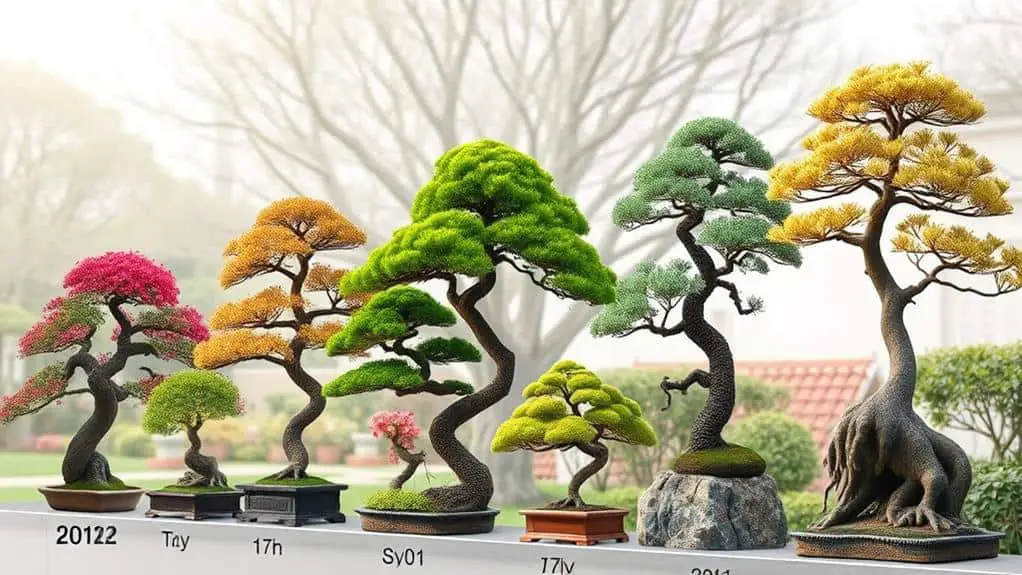
When it comes to bonsai trees, growth rates can really vary depending on the species you choose.
For example, junipers grow between 6 to 12 inches per year, while Chinese Elms can grow up to 48 inches annually.
Understanding these differences helps you plan your care and maintenance routine to keep your bonsai thriving.
Growth Rate Variability
Due to the immense variability in growth rates among different bonsai species, it's essential to choose the right tree based on your patience and cultivation goals.
Some species, like junipers, grow 6-12 inches per year, while others like ficus can grow 1-2 feet indoors and up to 6 feet outdoors.
Chinese elms, great for beginners, can grow 12-48 inches annually, offering versatility for both indoor and outdoor settings.
Jade plants grow slowly, taking up to 20 years to mature.
Pines, although fast-growing, need careful pruning to manage their size.
Understanding these growth characteristics helps set realistic expectations and timelines, ensuring your bonsai journey is both rewarding and enjoyable.
Common Bonsai Species
Choosing the right bonsai species is key to a successful and enjoyable bonsai-growing experience.
Let's explore some common bonsai species and their growth rates.
Junipers are hardy and grow 6-12 inches per year, thriving outdoors.
Ficus trees grow faster, reaching 1-2 feet indoors and up to 6 feet outdoors, making them great for indoor bonsai.
Chinese Elms are versatile, growing 12-48 inches yearly, and suit both beginners and experts.
Jade Plants are slow growers, taking up to 20 years to mature, ideal for indoor settings.
Ultimately, Pine trees are classic but need careful pruning to manage their vigorous growth.
Knowing these growth rates helps you decide how much time you're willing to invest to grow a bonsai tree.
Care and Maintenance
Caring for a bonsai tree isn't just about watering and sunlight; it's a nuanced process that directly affects how quickly your tree grows. Each species has unique needs, and understanding these is key to proper care and maintenance.
For example, Junipers grow 6-12 inches annually, while Chinese Elms can reach up to 48 inches. Ficus trees, another popular choice, grow 1-2 feet per year indoors.
Here's what you need to focus on:
- *Pruning techniques:* Regular pruning helps manage growth and shape.
- *Bonsai soil:* Use well-draining soil to prevent root rot.
- *Watering habits:* Adjust based on species; some need more frequent watering.
Care and Maintenance
For bonsai enthusiasts, proper care and maintenance are the bedrock of cultivating a thriving miniature tree.
Pruning helps shape your bonsai and promotes dense foliage, which boosts its overall health. Fertilization is equally important, as it replenishes the soil with essential nutrients, encouraging robust growth.
Remember to adjust your care seasonally; this means giving your bonsai adequate light and adjusting watering frequency based on the time of year. Since bonsai are grown in small pots, regular watering is vital because they hold limited moisture.
You'll also need to thin and repot the roots every 2-5 years to prevent them from becoming root-bound.
With consistent attention, your bonsai will flourish beautifully.
Techniques to Accelerate Growth
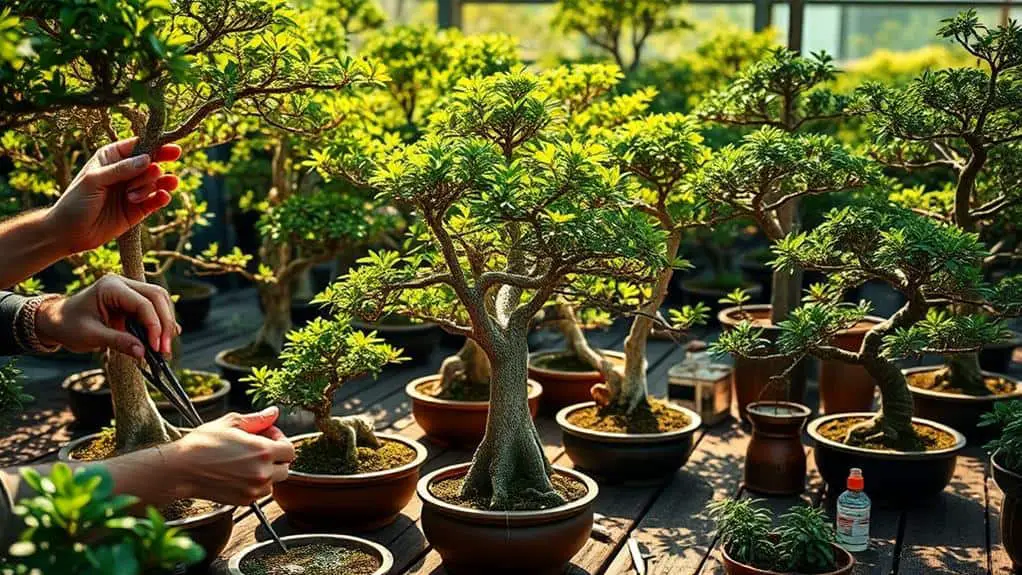
When trying to speed up your bonsai tree's growth, there are a few key techniques to keep in mind.
First, choosing the right soil helps support strong roots and keeps the plant hydrated.
Regular pruning and proper fertilization also play essential roles in promoting faster, healthier growth.
Optimal Soil Selection
To speed up the growth of your bonsai tree, you'll want to zero in on selecting the right soil.
Ideal soil selection is essential because it guarantees healthy root development and overall tree vitality. Here's what you need to know:
- Well-Draining Soil: Prevents waterlogging and promotes healthy root development.
- Soil Mix: Use a blend of organic and inorganic materials like akadama, pumice, and lava rock for moisture retention and aeration.
- Repotting Every 2-5 Years: Provides fresh nutrients and space for root expansion, encouraging vigorous growth.
Regularly testing and adjusting soil pH to the ideal range of 6.0 to 7.0 can greatly impact nutrient absorption.
Tailoring your soil mix to the specific species of your bonsai also supports ideal growth.
Regular Pruning Practices
Having the right soil is just one part of the equation; regular pruning practices are equally important for accelerating your bonsai tree's growth. Pruning shapes your bonsai, promotes denser foliage, and enhances healthy growth by encouraging branching. Techniques like cut-and-grow, annual trimming, and side-branch extension speed up trunk growth and improve your bonsai's look.
Start pruning after the initial growth phase, usually around two years in. This gives your tree a strong foundation.
Consistent pruning maintains the desired shape, improves light exposure, and boosts air circulation. These factors are essential for healthy growth.
When you pair pruning with nutrient replenishment, your bonsai's growth potential and liveliness will soar. Keep pruning, and you'll see amazing results!
Proper Fertilization Techniques
Of all the ways to boost your bonsai tree's growth, proper fertilization techniques stand out as particularly effective.
Fertilization is key for replenishing nutrients in bonsai soil, usually every 4-6 weeks during the growing season. Here's what you need to know:
- Balanced Fertilizer: Using an NPK fertilizer guarantees your bonsai gets nitrogen, phosphorus, and potassium for healthy growth.
- Liquid vs. Granules: Liquid fertilizers offer quick absorption, while slow-release granules provide a steady nutrient supply.
- Species-Specific Needs: Adjust the fertilization based on your bonsai species and growth stage for best results.
Monitor your tree's response by observing leaf color and growth rate. This helps fine-tune your approach, assuring your bonsai thrives.
Lifespan of Bonsai Trees
A well-cared-for bonsai tree can be a lifelong companion, with most species living between 50 to 80 years and some even surpassing a century. The lifespan of bonsai trees depends largely on proper care, regular pruning, and favorable growing conditions.
Some bonsai specimens can even live for around 1,000 years, becoming treasured heirlooms over generations.
To extend the life of your bonsai, focus on its long growth time and commit to diligent care. This means providing the right amount of water, light, and nutrients.
Longevity is also influenced by the specific species you choose. Many bonsai enthusiasts cultivate their trees with the hope that they'll outlive them, creating a lasting legacy for future generations.
Growing Bonsai From Scratch
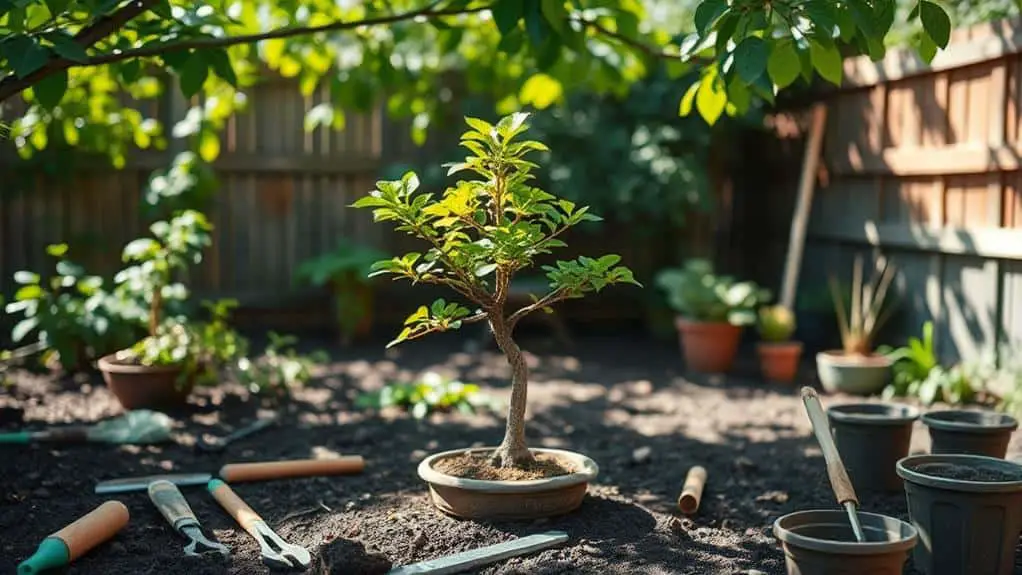
Starting a bonsai tree from scratch is a rewarding yet time-consuming endeavor that requires patience and dedication.
Growing a bonsai involves nurturing a tree from a seed or a small sapling, and it typically takes a minimum of five years to see initial stunting before true bonsai characteristics emerge.
Here are some key points to get you started:
- Plant multiple seeds to increase the chances of successful growth due to low germination rates.
- Start with a local sapling to enhance success rates, as it will be better adapted to your climate.
- Regular pruning and watering are essential to maintain the small size and shape of the bonsai.
Embrace this art, and your tree will grow beautifully over time.
Fast-Growing Bonsai Species
Having explored the commitment required to grow a bonsai from scratch, let's shift our focus to fast-growing bonsai species that can expedite the journey.
If you're keen to see progress quickly, you need to know about Junipers, which can grow 6-12 inches per year and thrive outdoors.
Ficus trees are another great option, growing 1-2 feet indoors and 4-6 feet outdoors annually.
Chinese Elms, suitable for beginners and pros alike, can grow an impressive 12-48 inches each year.
While Jade Plants are slower, taking up to 20 years old to mature, they're still a favorite among enthusiasts.
Other hardy choices include Aspen, Maple, and Weeping Willow, all of which can handle structural pruning.
Ensuring Strong Trunk Growth
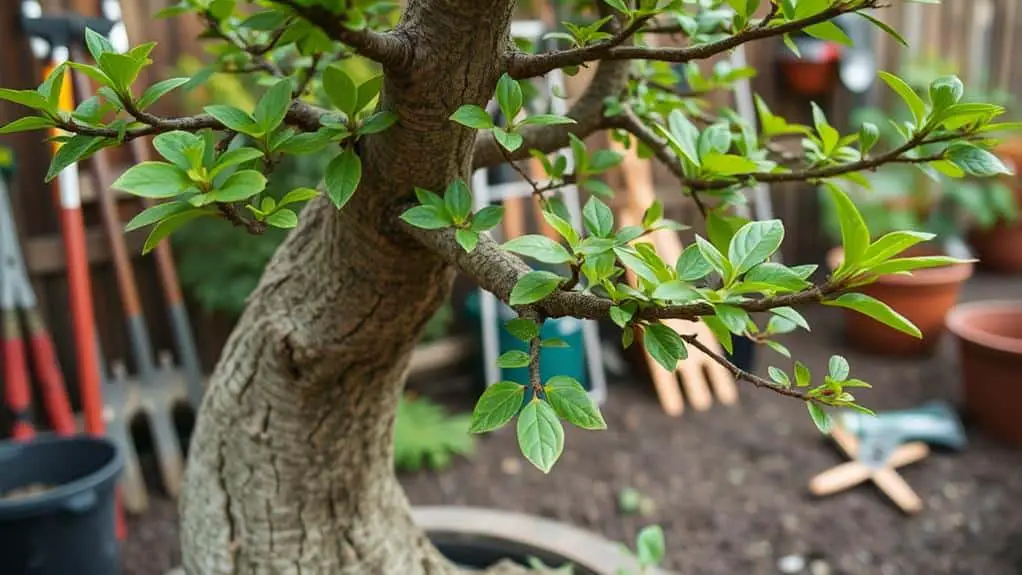
When it comes to ensuring strong trunk growth in your bonsai tree, employing the right techniques is fundamental for success.
To help you achieve healthy trunk development, consider these key methods:
- Cut-and-grow: This technique involves careful pruning to encourage a thicker trunk.
- Bend-and-grow: Shape the trunk while thickening it by applying tension over time.
- Regular fertilization: Provide nutrients for healthy trunk growth and overall tree importance.
Annual trimming is also significant; it maintains the desired shape and promotes robust trunk and branch growth.
Don't forget to monitor your watering practices. Adjust them based on your bonsai's species-specific needs to prevent overwatering, which can weaken trunk strength.
Community and Resources
Engaging with the bonsai community and utilizing available resources can greatly enhance your bonsai growing journey.
Community forums are fantastic for sharing knowledge and getting support from fellow bonsai growers. When you encounter common challenges or have questions, these forums can be a lifesaver.
Local bonsai clubs offer hands-on resources and networking opportunities. You'll meet experienced practitioners who can provide invaluable advice.
Online courses taught by award-winning experts are another excellent resource. They offer extensive learning opportunities suitable for any skill level.
Expert consultations can give you personalized guidance, helping you tailor your care techniques to your specific bonsai species.
Don't forget about local potters, who can create custom pottery to enhance your bonsai experience.
Frequently Asked Questions
How Fast Can You Grow a Bonsai Tree?
You can accelerate bonsai growth rates by selecting ideal species like Ficus or Chinese Elm. Environmental factors, such as light and watering, play an essential role. With proper care, you'll see significant growth within a few years.
Are Bonsai Trees Hard to Grow?
I don't think bonsai trees are too hard to grow, especially with the right bonsai tree care. Choosing ideal bonsai species like Chinese Elm or Ficus helps. Avoiding common bonsai mistakes like overwatering also makes it easier.
How Can I Make My Bonsai Grow Faster?
To make my bonsai grow faster, I select the right fertilizer types, use precise pruning techniques, and guarantee ideal lighting. Regular watering and repotting also help. Monitoring soil moisture and adjusting care routines are essential for healthy growth.
How Old Should a Tree Be Before Bonsai?
A tree should be at least 5 years old before starting bonsai. The tree species, training techniques, and pot selection all influence its readiness. Starting older trees helps you see quicker results, making your efforts more rewarding.
Conclusion
Growing a bonsai tree takes time and patience, but it's an incredibly rewarding journey. Remember, every step you take—whether it's choosing the right species, providing proper care, or learning new techniques—brings you closer to nurturing a beautiful, miniature tree. Don't be discouraged by the time it takes; instead, enjoy the process and watch your bonsai thrive. With dedication and the right resources, you're well on your way to becoming a confident bonsai gardener.

